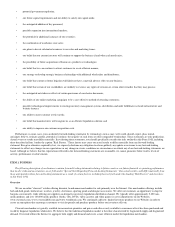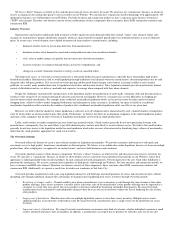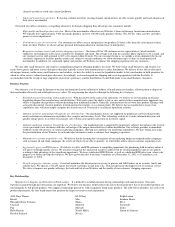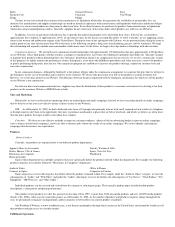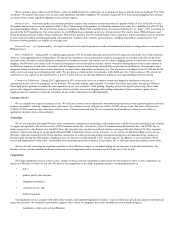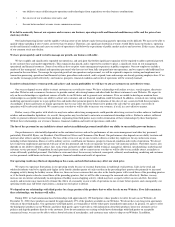Overstock.com 2002 Annual Report Download - page 14
Download and view the complete annual report
Please find page 14 of the 2002 Overstock.com annual report below. You can navigate through the pages in the report by either clicking on the pages listed below, or by using the keyword search tool below to find specific information within the annual report.
A significant number of merchandise returns could harm our business, financial condition and results of operations.
We allow our customers to return products. Our ability to handle a large volume of returns is unproven. In addition, any policies intended to reduce the
number of product returns may result in customer dissatisfaction and fewer return customers. If merchandise returns are significant, our business, financial
condition and results of operations could be harmed.
If the products that we offer on our Websites do not reflect our customers' tastes and preferences, our sales and profit margins would decrease.
Our success depends in part on our ability to offer products that reflect consumers' tastes and preferences. Consumers' tastes are subject to frequent,
significant and sometimes unpredictable changes. Because the products that we sell typically consist of manufacturers' and retailers' excess inventory, we have
limited control over the specific products that we are able to offer for sale. If our merchandise fails to satisfy customers' tastes or respond to changes in
customer preferences, our sales could suffer and we could be required to mark down unsold inventory which would depress our profit margins. In addition,
any failure to offer products in line with customers' preferences could allow our competitors to gain market share. This could have an adverse effect on our
business, results of operations and financial condition.
If the single facility where substantially all of our computer and communications hardware are located fails, our business, results of operations and
financial condition will be harmed.
Our success, and, in particular, our ability to successfully receive and fulfill orders and provide high-quality customer service, largely depends on the
efficient and uninterrupted operation of our computer and communications hardware systems. Substantially all of our computer and communications hardware
is located at a single leased facility in Salt Lake City, Utah. Our systems and operations are vulnerable to damage or interruption from fire, flood, power loss,
telecommunications failure, terrorist attacks, acts of war, break-ins, earthquake and similar events. We do not presently have redundant systems in multiple
locations or a formal disaster recovery plan and our business interruption insurance may be insufficient to compensate us for losses that may occur. Despite
the implementation of network security measures, our servers are vulnerable to computer viruses, physical or electronic break-ins and similar disruptions,
which could lead to interruptions, delays, loss of critical data or the inability to accept and fulfill customer orders. The occurrence of any of the foregoing risks
could harm our business, prospects, financial condition and results of operations.
We may be unable to protect our proprietary technology or keep up with that of our competitors.
Our success depends to a significant degree upon the protection of our software and other proprietary intellectual property rights. We may be unable to
deter misappropriation of our proprietary information, detect unauthorized use and take appropriate steps to enforce our intellectual property rights. In
addition, our competitors could, without violating our proprietary rights, develop technologies that are as good as or better than our technology.
Our failure to protect our software and other proprietary intellectual property rights or to develop technologies that are as good as our competitors' could
put us at a disadvantage to our competitors. In addition, the failure of the third parties whose products we offer for sale on our Websites to protect their
intellectual property rights, including their domain names, could impair our operations. These failures could harm our business, results of operations and
financial condition.
If we do not respond to rapid technological changes, our services could become obsolete and we could lose customers.
To remain competitive, we must continue to enhance and improve the functionality and features of our e-commerce businesses. We may face material
delays in introducing new services, products and enhancements. If this happens, our customers may forgo the use of our Websites and use those of our
competitors. The Internet and the online commerce industry are rapidly changing. If competitors introduce new products and services using new technologies
or if new industry standards and practices emerge, our existing Websites and our proprietary technology and systems may become obsolete. Our failure to
respond to technological change or to adequately maintain, upgrade and develop our computer network and the systems used to process customers' orders and
payments could harm our business, prospects, financial condition and results of operations.
Issuances of our securities are subject to federal and state securities laws, and certain holders of common stock issued by us may be entitled to
rescind their purchases.
Issuances of securities are subject to federal and state securities laws. From November 1999 through September 2000, we offered and sold common stock
to investors in various states. Certain of those offerings may not have complied with various requirements of applicable state securities laws. In such situations
a number of remedies may be available to regulatory authorities and the investors who purchased common stock in those offerings, including, without
limitation, a right of rescission, civil penalties, seizure of our assets, a restraining order or injunction, and a court order to pay restitution and costs. As a result,
certain investors in our common stock may be entitled to return their shares to Overstock and receive from us the full price they paid, plus interest, which we
estimate to be an aggregate amount of approximately $4.4 million at December 31, 2002.
We face risks relating to our inventory.
We directly purchase some of the merchandise that we sell on our Websites. We assume the inventory damage, theft and obsolescence risks, as well as
price erosion risks for products that we purchase directly. These risks are especially significant because some of the merchandise we sell at our Websites are
characterized by rapid technological change, obsolescence and price erosion (for example, computer hardware, software and consumer electronics), and
because we sometimes make large purchases of particular types of inventory. In addition, we often do not receive warranties on the merchandise we purchase.
In the recent past, we have recorded charges for obsolete inventory and have had to sell certain merchandise at a discount or loss. It is impossible to
determine with certainty whether an item will sell for more than the price we pay for it. Because we rely heavily on purchased inventory, our success will
depend on our ability to liquidate our inventory rapidly, the ability of our buying staff to purchase inventory at attractive prices relative to its resale value and
our ability to manage customer returns and the shrinkage resulting from theft, loss and misrecording of inventory. If we are unsuccessful in any of these areas,
we may be forced to sell our inventory at a discount or loss.
We may be liable if third parties misappropriate our customers' personal information.


